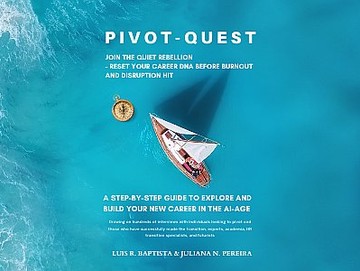Acquisitions editors and literary agents want to be excited.
One of the smartest things I’ve heard anyone say about writing a book proposal is this:
"You have to make one real human being -- who happens to read a lot of books -- like your book."
One real human being.
Most authors and writers overthink, and therefore, overwhelm themselves with the proposal. Which makes it a massive task. Don’t do that.
When writing the proposal, authors are often thinking about getting lots of people to read their book. That is a mistake.
*Remember, getting published or landing a good book deal is all about winning over one person — one acquiring editor at a major publishing imprint. Not the masses.
I’m going to break down the five parts of a proposal and make it as easy as possible for you to start writing right now. 1,000 words never came so easy.
Part 1: The Synopsis
(about 300 words)
This is the first thing an acquiring editor at a publishing house is going to read. This is where you sell them on your vision for the idea. This is where you put your true niche or story on display.
The Synopsis must be a convincing summary for why your book is relevant to a specific group of readers and why you are the one to write it. An acquisitions editor will judge this section by how excited they are to work with the idea and get behind it with some editing and marketing resources.
All publishers are looking for a ‘unique twist on a trendy topic’. Broad, general, and oversaturated topics lose interest quickly.
For nonfiction books, write the Synopsis in three paragraphs:
- The problem in the market for the target reader. Be detailed on the pain points and bring in some outside research or evidence for support.
- The solution your book has for them. Explain your methodology in detail and include clear bullet points as takeaways.
- Why you’re the one to write it? Mention your credentials, background, and any results with your work or clients that are relevant.
Consider these questions when writing the Synopsis:
- Why is the message or main theme of your book unique?
- What type of readers is it going to connect with?
- Can you sum up the idea in one catchy sentence?
Talk to the readers when you write this and refer to them as “you”. When you talk about yourself, refer to yourself in the third person.
If this is a fiction book, then this is where you explain the plot and give a summary of the main parts. This is also where you describe each main character and how they develop throughout the manuscript.
Part 2: The Sales Arguments
(about 100 words)
Every proposal must show details about the author.
Acquisitions editors take into account your previous success, earned influence, and the overall potential you give your book once acquired.
This is often referred to as the author platform. In this section, explain briefly how you will market the title to your community and how that can grow over the coming years. This includes your social media network, your media history, and your real-life network.
This section should have a combination of the following:
- What is your email list size? Newsletter engagement?
- How big is your social media following?
- How many page views does your professional website receive?
- Do you have any speaking engagements scheduled, past and future?
- Which endorsers and corporate sponsors will support you?
- Do you have an influencer writing the foreword?
- Any link to regular contributions to publications or media?
- Have you published a popular blog post on the topic?
- How about online community events or courses you’re developing?
- Do you have any praise from previous books?
- Lastly, what trends or industry statistics support the problem in your Synopsis?
It’s important to include actual numbers for the above, as well as anything else you feel is relevant.
The Sales Argument is the beginning of your marketing plan. It doesn't need to be a hugely detailed go-to-market plan, but you must share what you as the author bring to the table in terms of following and community. This is where all books gain traction and make the difference between a publisher getting you into bookstores or not. And so, this is also a main criterion they use to decide about offering a publishing deal.
Part 3: The Similar Titles
(about 100 words)
Remember in The Synopsis when I said that broad, general, and oversaturated topics lose interest quickly? That’s true for your idea, but not for your competition or similar titles.
- Search Amazon for the main keywords in your book and look at the number of reviews they have. If they have a lot then that means they’ve sold a lot of copies, and that’s a good title to reference. That means there is a big readership for that category. If it’s low on reviews it’s not a good title to mention or reference.
- List three others and explain how is yours different, similar, and/or better. Please provide the book title, author name, publisher, and publication date (should be within the last 5 years). Ideally, you’ve read these books and can act as research for your own.
This section is crucial. If you say anything about it being the first of its kind or that there is no other book like it, then acquisitions editors and publishers will know you haven’t done your homework.
Show the editor you know where it fits in the market. This is how they decide if it will fit with their bookstore distribution.
As a general rule, be sure these are published titles, and not self-published. Amazon will tell you this; scroll down to the Publisher details.
This section can also help you come up with book title concepts and it's common to offer an editor multiple title options that they can choose from. From this list of similar titles, determine which titles are already out there and what pain points they are covering. You can infer this by reading the Synopsis of the titles on Amazon.
Now, how might yours be unique and different, and appeal to the same readers? This may also affect how you position your Synopsis. So these sections should all work together.
Part 4: The Target Reader
(50 words)
For whom is the book primarily written? Describe how they connect to the problem/solution in your Synopsis.
Is it a broad audience, (all men over age 30) or a more niche audience (women leaders in transition between the ages of 30 and 35)?
For nonfiction, it often helps to ask if you had one perfect reader to write this book for, who would it be? And why is yours a perfect fit? Again, think about the problem/solution from the Synopsis, and how the idea is relevant to your own community or author platform. This is your target audience or reader.
Research trends of stats about your topic or ideal reader. i.e. According to studies, 78% of business owners say they want to implement influencer marketing but don't have the proper steps to take action within the next six months. If you're writing a book on digital marketing or a self-help for small businesses, then this may be a very relevant pain point to mention or base a part of your book on.
These are also things that acquisitions editors look for because it shows them you're not only a subject matter expert but that you know your industry and have the capacity to be a true thought leader.
For fiction, this section is not as important because if the plot and quality of your manuscript are good enough, then a publisher will get it in front of your genre readers.
Part 5: The Outline
(about 450 words)
This is where you show how your entire book is structured. This is also called your annotated table of contents.
Start by laying out each chapter or part. It’s likely this section will change over time as you finish writing and your samples and manuscript but it’s good to show publishers how you imagine it coming together ahead of time.
Editors spend all day opening proposal submissions and they each have their own sections they go to first to decide if they should continue reviewing. Most will go to the detailed table of contests early because it helps ground the idea and lets them know really how you envision the final product turning out.
For nonfiction, you want this structure:
- List the number and title of each chapter. It should be very clear and organized. *Never use all caps (unless you’re naming a fictional character).
- In 1–2 sentences each, describe what the chapter is about. It’s okay to be brief here, but provide enough detail that an acquisition editor understands why this chapter is important to the book and the main theme.
For fiction, describe the plot in more detail for each chapter and explain how it wraps around the characters without giving away the good stuff.
A quick tip: Ask a friend to read a few chapter descriptions. If they don’t understand it, then you should probably clarify further.
Bonus: Sample Chapters
Not every proposal needs sample chapters included. This is determined by the preferences of an editor or potential publisher and what they need in order to make a decision.
A literary agent likely won't read sample chapters at all unless the proposal excites them.
Oftentimes, if the first 5 sections of the proposal above are exciting and leaving them wanting more, they will request 1-3 sample chapters or sample writing as a next step. This is an indicator of interest and they will use it to learn the tone of voice and quality of storytelling. If they like it, they will introduce the book idea to their editorial board, who together, will decide if it fits into their upcoming front list of titles. What should you expect for this?
For nonfiction, have at least a sample writing up to 1,000 words to share with a very interested acquisition editor. Ideally, you are able to produce 1-3 proofread sample chapters (not include preface and introduction). If you don't have these once requested, you have time to write them and have your agent submit to the editor for consideration.
For fiction, you will likely need the entire finished manuscript to send once they request it. It is possible to get an offer without the full manuscript, but editors like to be sure the book ends well and also has a high chance of being approved by the editorial board.
Cheers,
Submit a book proposal on Publishizer at www.publishizer.com


